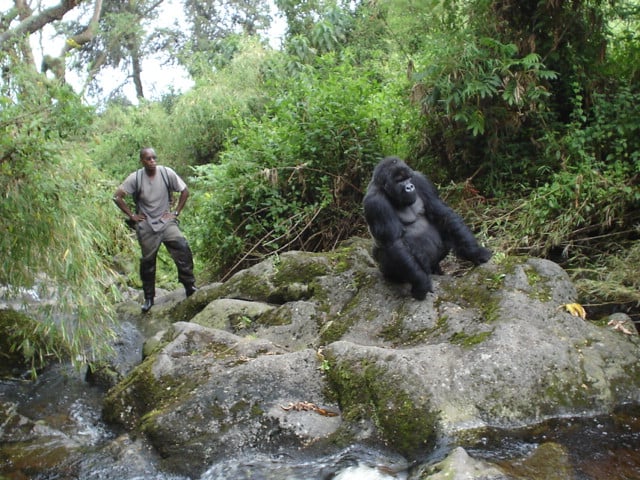 Felix Ndagijimana in the field
Felix Ndagijimana in the field
Seeing these magnificent creatures up close is an experience like no other, and I never grow tired of it. It makes you understand how closely connected we are to them—and once you see that, you understand, really understand, that we have a responsibility to protect them.
– Felix Ndagijimana, director of Rwanda programs and the Karisoke Research Center, Dian Fossey Gorilla Fund
September 24 is World Gorilla Day, which recognizes not just the majesty of gorillas, with whom we share more than 98% of our DNA, but also the threats to survival they face on our warming planet. We share our DNA with the gorillas, but we share our planet with them as well—and our efforts to save this endangered species will ultimately help us save ourselves.
The “lungs” of our planet
Gorillas live in the Congo basin, in the second-largest tropical rainforest left on earth, a forest that plays a critical role in our fight against climate change. It acts as the “lungs of the planet,” cleaning the air of the carbon dioxide that leads to climate change and replacing it with the clean oxygen that we need to breathe. Gorillas play an important part in keeping these lungs healthy, dispersing seeds, letting in light, and shaping plant communities within the forest.
Gorillas act as an “umbrella species” for their habitat, helping to protect biodiversity on a larger scale. Their forest habitat is home to numerous other species, many themselves endangered. Protecting gorillas helps protect these other vital plants, animals and insects as well. And maintaining an intact ecosystem can limit disease spillover from animals to humans—possibly preventing the next HIV, Ebola or COVID-19.
Back in camp, I reflect on the forest I have seen around me. This home to the Grauer’s gorilla is also host to other near-mythical mammals, including chimpanzees, giant pangolins and a variety of antelope. It harbors exciting bird species, such as the Bates’ paradise flycatcher and white-crested hornbill. It contains giant trees and is full of marvelously adapted insects. But more than a gathering of organisms this forest showcases what a tropical rainforest is all about: being a complex web of interactions.
-Dr. Yntze van der Hoek, biodiversity researcher, Dian Fossey Gorilla Fund
The human-gorilla connection
It’s not just about the animals and their habitat. At the Fossey Fund, we recognize that to protect the endangered mountain gorillas of Rwanda and the critically endangered Grauer’s gorillas of the Democratic Republic of the Congo, we need the support of the human communities that share this space. People rely on the forest and its environs for food, health and income; we give them the tools and education that allow them to thrive without going into the forest. We offer mushroom and bamboo cultivation programs that give people a reliable source of protein and income. We lead Conservation Clubs in primary and secondary schools so that children grow up understanding their connection to the nearby forest and take pride in their biodiverse land. And we offer training for college students at Karisoke, along with scholarships our own staff members, because we want to support the next generation of African conservationists.
The future of conservation depends on educating the next generation of leaders. We are proud to be contributing to this training—more than 85% of Rwandan undergraduate students who do their senior thesis work with us go on to careers in conservation or science, not just with gorillas but with other species of plants and animals.
-Dr. Tara Stoinski, CEO and chief scientific officer, Dian Fossey Gorilla Fund
Saving the planet, one gorilla at a time
World Gorilla Day was started in 2017 to coincide with the founding of Dian Fossey’s Karisoke Research Center 53 years ago. Today the Dian Fossey Gorilla Fund has more than 200 staff working in both Rwanda and the Democratic Republic of the Congo. We are in the forest 365 days a year, tracking gorillas, studying them and protecting them from poaching. We also work with the communities that live near the gorillas, offering food security programs, livelihood and education initiatives, because we understand that for the gorillas to survive, the human communities around them must also thrive.
 Jean Paul Hirwa monitoring gorillas
Jean Paul Hirwa monitoring gorillas
Gorillas have been pulled back from the brink of extinction due to “extreme conservation,” which focuses on daily protection of individual gorillas and their families. This painstaking and cost-intensive effort has moved the needle such that in 2018, mountain gorillas were reclassified from critically endangered to endangered: one small step further from extinction.
But we haven’t let up: Even in the midst of the COVID-19 pandemic, Fossey Fund trackers have not missed a day in the field protecting the gorillas, despite the fact that this means frequent separations from their own families.
On World Gorilla Day, we want people to know that the species is still in extreme danger, and we cannot let up in our conservation efforts. When gorillas are healthy, the forests in which they live are healthy as well, as are the other species of plants and animals who thrive in the gorillas’ habitat. Protecting gorillas protects us all.
I believe that saving all animals and plants is essential. But gorillas are actually special, special animals. We need to protect them always, as much as possible, so that they live forever.
– Jean Paul Hirwa, gorilla program manager, Dian Fossey Gorilla Fund






